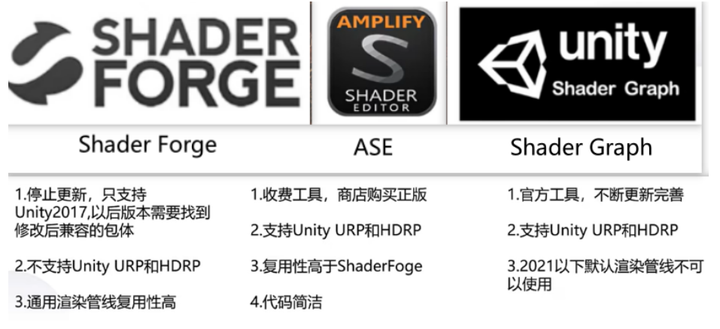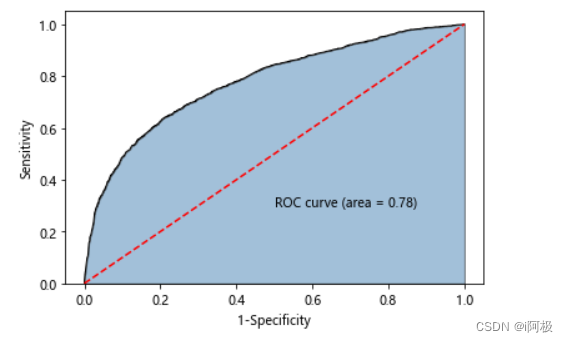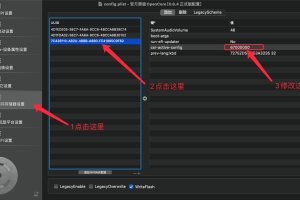3. 文件编程
non-blocking io 非阻塞 IO
1.1 Channel & Buffer
channel 类似于 stream,它就是读写数据的双向通道,可以从 channel 将数据读入 buffer,也可以将 buffer 的数据写入 channel,而之前的 stream 要么是输入,要么是输出,channel 比 stream 更为底层 .
常见的 Channel 有
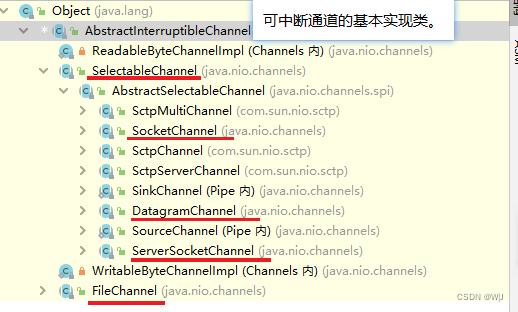
buffer 则用来缓冲读写数据,常见的 buffer 有
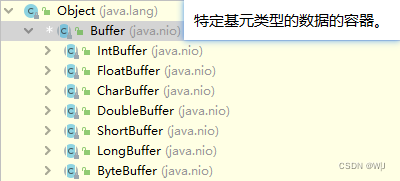
Selector
对象的多路复用器 SelectableChannel 。与本章图1 对应搭配使用
selector 版设计
selector 的作用就是配合一个线程来管理多个 channel,获取这些 channel 上发生的事件,这些 channel 工作在非阻塞模式下,不会让线程吊死在一个 channel 上。适合连接数特别多,但流量低的场景(low traffic)
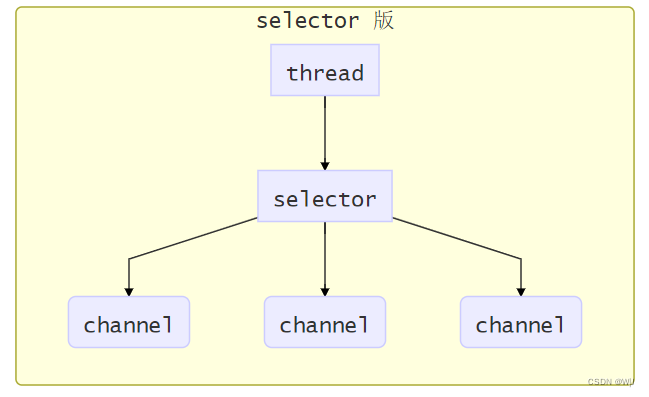
在 or select() select(long) 方法之一中阻塞的线程可能会被其他线程以以下三种方式之一中断:
调用 selector 的 select() 会阻塞直到 channel 发生了读写就绪事件,这些事件发生,select 方法就会返回这些事件交给 thread 来处理
2. ByteBuffer
FileChannel 还可以通过 java.nio.channels.FileChannel#open(java.nio.file.Path, java.nio.file.OpenOption...)创建

// 使用 FileChannel 来读取文件内容
@Slf4j
public class ChannelDemo1 {
public static void main(String[] args) {
try (RandomAccessFile file = new RandomAccessFile("helloword/data.txt", "rw")) {
FileChannel channel = file.getChannel();
ByteBuffer buffer = ByteBuffer.allocate(10);
do {
// 向 buffer 写入
int len = channel.read(buffer);
log.debug("读到字节数:{}", len);
if (len == -1) {
break;
}
// 切换 buffer 读模式
buffer.flip();
while(buffer.hasRemaining()) {
log.debug("{}", (char)buffer.get());
}
// 切换 buffer 写模式
buffer.clear();
} while (true);
} catch (IOException e) {
e.printStackTrace();
}
}
}ByteBuffer 结构
ByteBuffer 有以下重要属性
-
capacity
-
position
-
limit
一开始
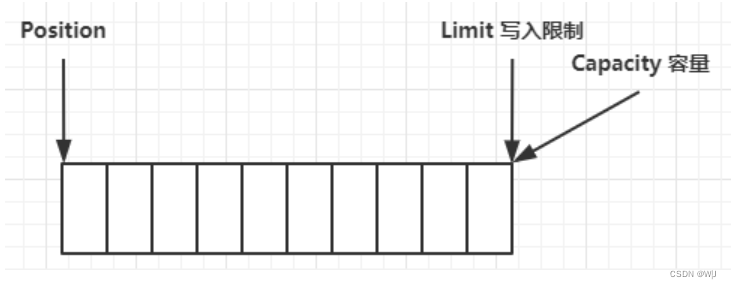
写模式下,position 是写入位置,limit 等于容量,下图表示写入了 4 个字节后的状态


flip 动作发生后,position 切换为读取位置,limit 切换为读取限制(准备相对获取 )



写入(read()) 4 个字节后,状态

clear 动作发生后,状态

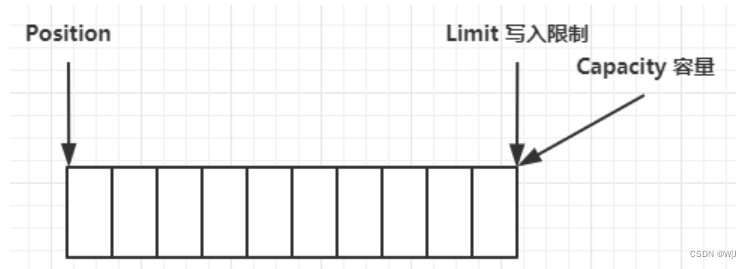
compact 方法,是把未读完的部分向前压缩,然后切换至写模式
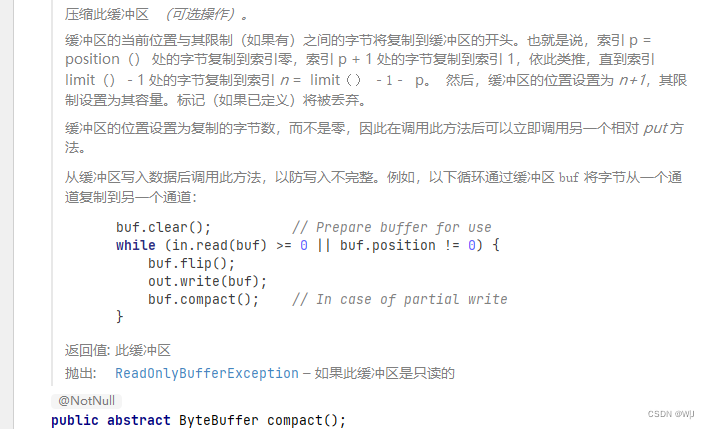

ByteBuffer 常见方法

2.6 练习
网络上有多条数据发送给服务端,数据之间使用 \n 进行分隔 但由于某种原因这些数据在接收时,被进行了重新组合,例如原始数据有3条为
-
Hello,world\n
-
I'm zhangsan\n
-
How are you?\n
变成了下面的两个 byteBuffer (黏包,半包)
-
Hello,world\nI'm zhangsan\nHo
-
w are you?\n
现在要求你编写程序,将错乱的数据恢复成原始的按 \n 分隔的数据
import java.nio.ByteBuffer;
public class TestByteBufferExam {
public static void main(String[] args) {
ByteBuffer source = ByteBuffer.allocate(32);
// 11 24
source.put("Hello,world\nI'm zhangsan\nHo".getBytes());
split(source);
source.put("w are you?\nhaha!\n".getBytes());
split(source);
}
private static void split(ByteBuffer source) {
source.flip(); // 为读取做准备
ByteBuffer target;
for (int i = 0; i < source.limit(); i++) {
if (source.get(i) == '\n') {
int length = i + 1 - source.position();
target = ByteBuffer.allocate(length);
byte[] dst = new byte[length];
source.get(dst, 0, length);
target.put(dst, 0, length);
// for (int j = 0; j < length; j++) {
// target.put(source.get());
// }
ByteBufferUtil.debugAll(target);
}
}
// 转换至写模式-因为没有读完只能用 compact 而不是 clear
source.compact();
}
}
用到的工具类
import io.netty.util.internal.StringUtil;
import java.nio.ByteBuffer;
import static io.netty.util.internal.MathUtil.isOutOfBounds;
import static io.netty.util.internal.StringUtil.NEWLINE;
public class ByteBufferUtil {
private static final char[] BYTE2CHAR = new char[256];
private static final char[] HEXDUMP_TABLE = new char[256 * 4];
private static final String[] HEXPADDING = new String[16];
private static final String[] HEXDUMP_ROWPREFIXES = new String[65536 >>> 4];
private static final String[] BYTE2HEX = new String[256];
private static final String[] BYTEPADDING = new String[16];
static {
final char[] DIGITS = "0123456789abcdef".toCharArray();
for (int i = 0; i < 256; i++) {
HEXDUMP_TABLE[i << 1] = DIGITS[i >>> 4 & 0x0F];
HEXDUMP_TABLE[(i << 1) + 1] = DIGITS[i & 0x0F];
}
int i;
// Generate the lookup table for hex dump paddings
for (i = 0; i < HEXPADDING.length; i++) {
int padding = HEXPADDING.length - i;
StringBuilder buf = new StringBuilder(padding * 3);
for (int j = 0; j < padding; j++) {
buf.append(" ");
}
HEXPADDING[i] = buf.toString();
}
// Generate the lookup table for the start-offset header in each row (up to 64KiB).
for (i = 0; i < HEXDUMP_ROWPREFIXES.length; i++) {
StringBuilder buf = new StringBuilder(12);
buf.append(NEWLINE);
buf.append(Long.toHexString(i << 4 & 0xFFFFFFFFL | 0x100000000L));
buf.setCharAt(buf.length() - 9, '|');
buf.append('|');
HEXDUMP_ROWPREFIXES[i] = buf.toString();
}
// Generate the lookup table for byte-to-hex-dump conversion
for (i = 0; i < BYTE2HEX.length; i++) {
BYTE2HEX[i] = ' ' + StringUtil.byteToHexStringPadded(i);
}
// Generate the lookup table for byte dump paddings
for (i = 0; i < BYTEPADDING.length; i++) {
int padding = BYTEPADDING.length - i;
StringBuilder buf = new StringBuilder(padding);
for (int j = 0; j < padding; j++) {
buf.append(' ');
}
BYTEPADDING[i] = buf.toString();
}
// Generate the lookup table for byte-to-char conversion
for (i = 0; i < BYTE2CHAR.length; i++) {
if (i <= 0x1f || i >= 0x7f) {
BYTE2CHAR[i] = '.';
} else {
BYTE2CHAR[i] = (char) i;
}
}
}
/**
* 打印所有内容
* @param buffer
*/
public static void debugAll(ByteBuffer buffer) {
int oldlimit = buffer.limit();
buffer.limit(buffer.capacity());
StringBuilder origin = new StringBuilder(256);
appendPrettyHexDump(origin, buffer, 0, buffer.capacity());
System.out.println("+--------+-------------------- all ------------------------+----------------+");
System.out.printf("position: [%d], limit: [%d]\n", buffer.position(), oldlimit);
System.out.println(origin);
buffer.limit(oldlimit);
}
/**
* 打印可读取内容
* @param buffer
*/
public static void debugRead(ByteBuffer buffer) {
StringBuilder builder = new StringBuilder(256);
appendPrettyHexDump(builder, buffer, buffer.position(), buffer.limit() - buffer.position());
System.out.println("+--------+-------------------- read -----------------------+----------------+");
System.out.printf("position: [%d], limit: [%d]\n", buffer.position(), buffer.limit());
System.out.println(builder);
}
private static void appendPrettyHexDump(StringBuilder dump, ByteBuffer buf, int offset, int length) {
if (isOutOfBounds(offset, length, buf.capacity())) {
throw new IndexOutOfBoundsException(
"expected: " + "0 <= offset(" + offset + ") <= offset + length(" + length
+ ") <= " + "buf.capacity(" + buf.capacity() + ')');
}
if (length == 0) {
return;
}
dump.append(
" +-------------------------------------------------+" +
NEWLINE + " | 0 1 2 3 4 5 6 7 8 9 a b c d e f |" +
NEWLINE + "+--------+-------------------------------------------------+----------------+");
final int startIndex = offset;
final int fullRows = length >>> 4;
final int remainder = length & 0xF;
// Dump the rows which have 16 bytes.
for (int row = 0; row < fullRows; row++) {
int rowStartIndex = (row << 4) + startIndex;
// Per-row prefix.
appendHexDumpRowPrefix(dump, row, rowStartIndex);
// Hex dump
int rowEndIndex = rowStartIndex + 16;
for (int j = rowStartIndex; j < rowEndIndex; j++) {
dump.append(BYTE2HEX[getUnsignedByte(buf, j)]);
}
dump.append(" |");
// ASCII dump
for (int j = rowStartIndex; j < rowEndIndex; j++) {
dump.append(BYTE2CHAR[getUnsignedByte(buf, j)]);
}
dump.append('|');
}
// Dump the last row which has less than 16 bytes.
if (remainder != 0) {
int rowStartIndex = (fullRows << 4) + startIndex;
appendHexDumpRowPrefix(dump, fullRows, rowStartIndex);
// Hex dump
int rowEndIndex = rowStartIndex + remainder;
for (int j = rowStartIndex; j < rowEndIndex; j++) {
dump.append(BYTE2HEX[getUnsignedByte(buf, j)]);
}
dump.append(HEXPADDING[remainder]);
dump.append(" |");
// Ascii dump
for (int j = rowStartIndex; j < rowEndIndex; j++) {
dump.append(BYTE2CHAR[getUnsignedByte(buf, j)]);
}
dump.append(BYTEPADDING[remainder]);
dump.append('|');
}
dump.append(NEWLINE +
"+--------+-------------------------------------------------+----------------+");
}
private static void appendHexDumpRowPrefix(StringBuilder dump, int row, int rowStartIndex) {
if (row < HEXDUMP_ROWPREFIXES.length) {
dump.append(HEXDUMP_ROWPREFIXES[row]);
} else {
dump.append(NEWLINE);
dump.append(Long.toHexString(rowStartIndex & 0xFFFFFFFFL | 0x100000000L));
dump.setCharAt(dump.length() - 9, '|');
dump.append('|');
}
}
public static short getUnsignedByte(ByteBuffer buffer, int index) {
return (short) (buffer.get(index) & 0xFF);
}
}3. 文件编程
3.1 FileChannel
⚠️ FileChannel 工作模式
FileChannel 只能工作在阻塞模式下
获取

读取
会从 channel 读取数据填充 ByteBuffer,返回值表示读到了多少字节,-1 表示到达了文件的末尾
int readBytes = channel.read(buffer);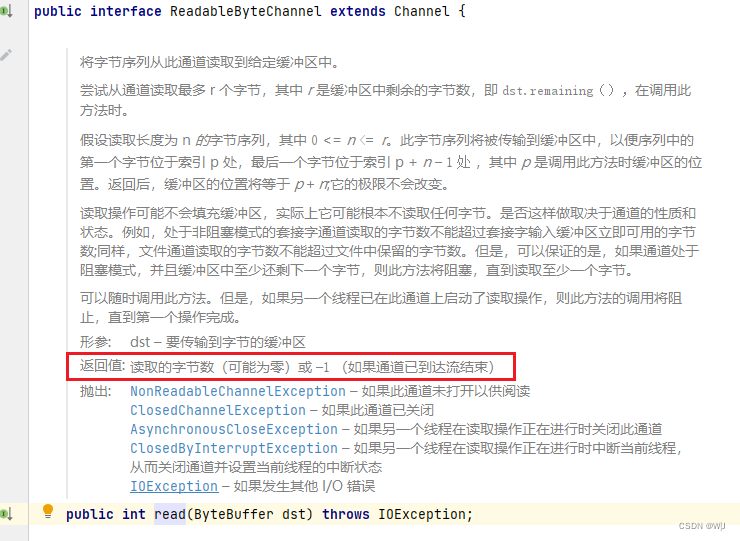
写入的正确姿势如下, SocketChannel
ByteBuffer buffer = ...;
buffer.put(...); // 存入数据
buffer.flip(); // 切换读模式
while(buffer.hasRemaining()) {
channel.write(buffer);
}在 while 中调用 channel.write 是因为 write 方法并不能保证一次将 buffer 中的内容全部写入 channel
关闭
channel 必须关闭,不过调用了 FileInputStream、FileOutputStream 或者 RandomAccess-File 的 close 方法会间接地调用 channel 的 close 方法
3.2 两个 Channel 传输数据
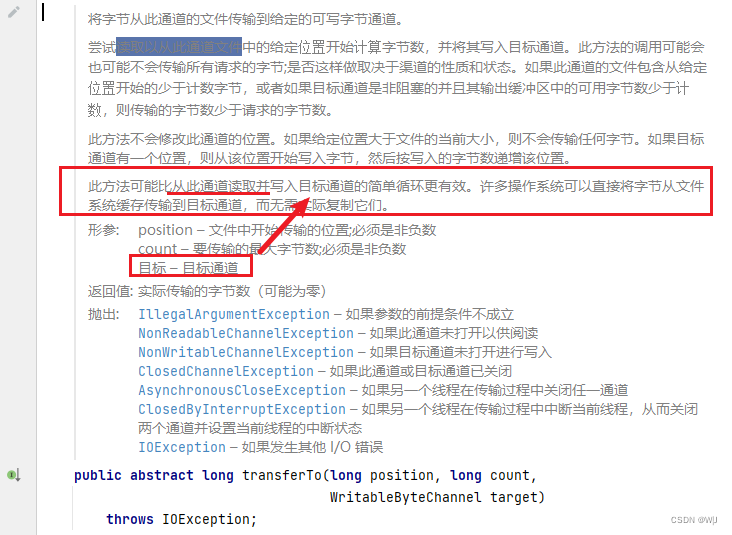
import java.io.FileInputStream;
import java.io.FileNotFoundException;
import java.io.FileOutputStream;
import java.io.IOException;
import java.nio.channels.FileChannel;
public class TestFileChannelTransferTo {
public static void main(String[] args) {
try (FileInputStream fileInputStream = new FileInputStream("data.txt")) {
FileChannel from = fileInputStream.getChannel();
FileChannel toChannel = new FileOutputStream("to.txt").getChannel();
// transferTo(from, toChannel);
transferTo2(from, toChannel);
} catch (FileNotFoundException e) {
e.printStackTrace();
} catch (IOException e) {
e.printStackTrace();
}
}
// 超过2GB时使用此方法 因为 字节数少于计数,则传输的字节数少于请求的字节数
private static void transferTo2(FileChannel from, FileChannel toChannel) throws IOException {
long originalSize = from.size();
for (int i = 0; i < originalSize;) {
i += from.transferTo(i, originalSize - i, toChannel);
}
}
/**
* 零拷贝, 最大只能 2GB
*
* @param from
* @param toChannel
* @throws IOException
*/
private static void transferTo(FileChannel from, FileChannel toChannel) throws IOException {
from.transferTo(0, from.size(), toChannel);
}
}
3.3 Path

-
.代表了当前路径 -
..代表了上一级路径
3.4 Files
创建多级目录用
Path path = Paths.get("helloword/d1/d2");
Files.createDirectories(path);拷贝文件
Path source = Paths.get("helloword/data.txt");
Path target = Paths.get("helloword/target.txt");
Files.copy(source, target);-
如果文件已存在,会抛异常 FileAlreadyExistsException
如果希望用 source 覆盖掉 target,需要用 StandardCopyOption 来控制
Files.copy(source, target, StandardCopyOption.REPLACE_EXISTING);
移动文件
Path source = Paths.get("helloword/data.txt");
Path target = Paths.get("helloword/data.txt");
Files.move(source, target, StandardCopyOption.ATOMIC_MOVE);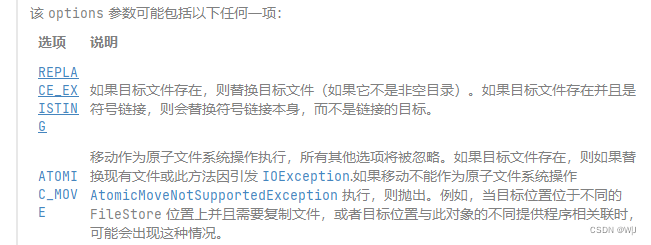
删除文件
Path target = Paths.get("helloword/target.txt");
Files.delete(target);
Files.deleteIfExists(target);walk方法
示例代码
import java.io.IOException;
import java.nio.file.*;
import java.nio.file.attribute.BasicFileAttributes;
import java.util.concurrent.atomic.LongAdder;
public class FilesTest {
public static final String FIRST = "E:\\360Downloads";
public static void main(String[] args) throws IOException {
// Files.deleteIfExists(Paths.get("E:\\360Downloads\\a\\b\\c"));
// create Directories();
// walk();
walk2();
}
private static void walk2() throws IOException {
String source = "E:\\Users\\Videos\\bilibili";
String target = "E:\\Users\\Videos\\bilibili2";
Files.walk(Paths.get(source)).forEach(sourcePath -> {
String targetPath = sourcePath.toString().replace(source, target);
try {
if(Files.isDirectory(sourcePath)){
Files.createDirectory(Paths.get(targetPath));
}
else if(Files.isRegularFile(sourcePath)){
Files.copy(sourcePath,Paths.get(targetPath));
}
} catch (IOException e) {
e.printStackTrace();
}
});
}
// 递归创建文件夹
private static void createDirectories() throws IOException {
Files.createDirectories(Paths.get("E:\\360Downloads\\a\\b\\c"));
}
// 访问者模式的体现
private static void walk() throws IOException {
LongAdder directoryAdder = new LongAdder();
LongAdder fileAdder = new LongAdder();
SimpleFileVisitor<Path> visitor = new SimpleFileVisitor<Path>() {
@Override
public FileVisitResult visitFile(Path file, BasicFileAttributes attrs) throws IOException {
fileAdder.increment();
Files.delete(file);
return super.visitFile(file, attrs);
}
@Override
public FileVisitResult postVisitDirectory(Path dir, IOException exc) throws IOException {
directoryAdder.increment();
Files.delete(dir);
return super.postVisitDirectory(dir, exc);
}
};
Files.walkFileTree(Paths.get(FIRST), visitor);
System.out.println("文件累计" + fileAdder);
System.out.println("文件夹累计" + directoryAdder);
}
}
4. 网络编程
4.1 非阻塞 vs 阻塞
阻塞
-
阻塞模式下,相关方法都会导致线程暂停
-
ServerSocketChannel.accept 会在没有连接建立时让线程暂停
-
SocketChannel.read 会在没有数据可读时让线程暂停
-
阻塞的表现其实就是线程暂停了,暂停期间不会占用 cpu,但线程相当于闲置
-
-
单线程下,阻塞方法之间相互影响,几乎不能正常工作,需要多线程支持
-
但多线程下,有新的问题,体现在以下方面
-
32 位 jvm 一个线程 320k,64 位 jvm 一个线程 1024k,如果连接数过多,必然导致 OOM,并且线程太多,反而会因为频繁上下文切换导致性能降低
-
可以采用线程池技术来减少线程数和线程上下文切换,但治标不治本,如果有很多连接建立,但长时间 inactive,会阻塞线程池中所有线程,因此不适合长连接,只适合短连接
-
服务器端
/ 使用 nio 来理解阻塞模式, 单线程
// 0. ByteBuffer
ByteBuffer buffer = ByteBuffer.allocate(16);
// 1. 创建了服务器
ServerSocketChannel ssc = ServerSocketChannel.open();
// 2. 绑定监听端口
ssc.bind(new InetSocketAddress(8080));
// 3. 连接集合
List<SocketChannel> channels = new ArrayList<>();
while (true) {
// 4. accept 建立与客户端连接, SocketChannel 用来与客户端之间通信
log.debug("connecting...");
SocketChannel sc = ssc.accept(); // 阻塞方法,线程停止运行
log.debug("connected... {}", sc);
channels.add(sc);
for (SocketChannel channel : channels) {
// 5. 接收客户端发送的数据
log.debug("before read... {}", channel);
channel.read(buffer); // 阻塞方法,线程停止运行
buffer.flip();
// 或者搜索 <工具类>
ByteBufferUtil.debugRead(buffer);
buffer.clear();
log.debug("after read...{}", channel);
}
}客户端
SocketChannel sc = SocketChannel.open();
sc.connect(new InetSocketAddress("localhost", 8080));
System.out.println("waiting...");非阻塞
-
非阻塞模式下,相关方法都会不会让线程暂停
-
在 ServerSocketChannel.accept 在没有连接建立时,会返回 null,继续运行
-
SocketChannel.read 在没有数据可读时,会返回 0,但线程不必阻塞,可以去执行其它 SocketChannel 的 read 或是去执行 ServerSocketChannel.accept
-
写数据时,线程只是等待数据写入 Channel 即可,无需等 Channel 通过网络把数据发送出去
-
-
但非阻塞模式下,即使没有连接建立,和可读数据,线程仍然在不断运行,白白浪费了 cpu
-
数据复制过程中,线程实际还是阻塞的(AIO 改进的地方)
服务器端,客户端代码不变
// 服务端代码微调 ServerSocketChannel ssc; SocketChannel sc
ssc.configureBlocking(false); // 非阻塞模式
sc.configureBlocking(false); // 非阻塞模式
多路复用
单线程可以配合 Selector 完成对多个 Channel 可读写事件的监控,这称之为多路复用
-
多路复用仅针对网络 IO、普通文件 IO 没法利用多路复用
-
如果不用 Selector 的非阻塞模式,线程大部分时间都在做无用功,而 Selector 能够保证
-
有可连接事件时才去连接
-
有可读事件才去读取
-
有可写事件才去写入
-
限于网络传输能力,Channel 未必时时可写,一旦 Channel 可写,会触发 Selector 的可写事件
-
-
4.2 Selector
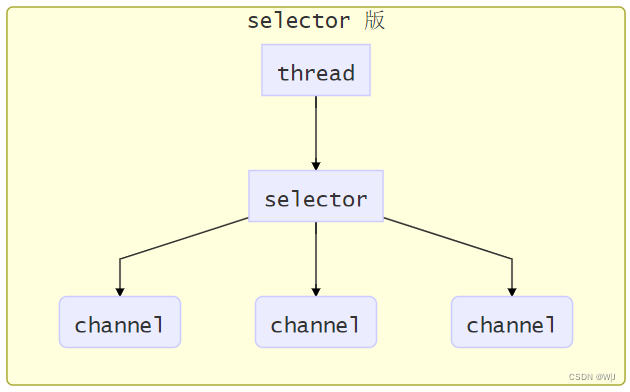
好处
-
一个线程配合 selector 就可以监控多个 channel 的事件,事件发生线程才去处理。避免非阻塞模式下所做无用功
-
让这个线程能够被充分利用
-
节约了线程的数量
-
减少了线程上下文切换
创建
Selector selector = Selector.open();
绑定 Channel 事件
也称之为注册事件,绑定的事件 selector 才会关心
channel.configureBlocking(false); SelectionKey key = channel.register(selector, 绑定事件);
-
channel 必须工作在非阻塞模式
-
FileChannel 没有非阻塞模式,因此不能配合 selector 一起使用
-
绑定的事件类型可以有
-
connect - 客户端连接成功时触发
-
accept - 服务器端成功接受连接时触发
-
read - 数据可读入时触发,有因为接收能力弱,数据暂不能读入的情况
-
write - 数据可写出时触发,有因为发送能力弱,数据暂不能写出的情况
-
监听 Channel 事件
可以通过下面三种方法来监听是否有事件发生,方法的返回值代表有多少 channel 发生了事件
方法1,阻塞直到绑定事件发生
int count = selector.select();
方法2,阻塞直到绑定事件发生,或是超时(时间单位为 ms)
int count = selector.select(long timeout);
方法3,不会阻塞,也就是不管有没有事件,立刻返回,自己根据返回值检查是否有事件
int count = selector.selectNow();
💡 select 何时不阻塞
事件发生时
客户端发起连接请求,会触发 accept 事件
客户端发送数据过来,客户端正常、异常关闭时,都会触发 read 事件,另外如果发送的数据大于 buffer 缓冲区,会触发多次读取事件
channel 可写,会触发 write 事件
在 linux 下 nio bug 发生时
调用 selector.wakeup()
调用 selector.close()
selector 所在线程 interrupt
4.3 处理 accept 事件
客户端代码为
public class Client {
public static void main(String[] args) {
try (Socket socket = new Socket("localhost", 8080)) {
System.out.println(socket);
socket.getOutputStream().write("world".getBytes());
System.in.read();
} catch (IOException e) {
e.printStackTrace();
}
}
}服务器端代码为
@Slf4j
public class ChannelDemo6 {
public static void main(String[] args) {
try (ServerSocketChannel channel = ServerSocketChannel.open()) {
channel.bind(new InetSocketAddress(8080));
System.out.println(channel);
Selector selector = Selector.open();
channel.configureBlocking(false);
channel.register(selector, SelectionKey.OP_ACCEPT);
while (true) {
int count = selector.select();
// int count = selector.selectNow();
log.debug("select count: {}", count);
// if(count <= 0) {
// continue;
// }
// 获取所有事件
Set<SelectionKey> keys = selector.selectedKeys();
// 遍历所有事件,逐一处理
Iterator<SelectionKey> iter = keys.iterator();
while (iter.hasNext()) {
SelectionKey key = iter.next();
// 判断事件类型
if (key.isAcceptable()) {
ServerSocketChannel c = (ServerSocketChannel) key.channel();
// 必须处理
SocketChannel sc = c.accept();
log.debug("{}", sc);
}
// 处理完毕,必须将事件移除
iter.remove();
}
}
} catch (IOException e) {
e.printStackTrace();
}
}
}💡 事件发生后能否不处理
事件发生后,要么处理,要么取消(cancel),不能什么都不做,否则下次该事件仍会触发,这是因为 nio 底层使用的是水平触发
💡 为何要 iter.remove()
因为 select 在事件发生后,就会将相关的 key 放入 selectedKeys 集合,但不会在处理完后从 selectedKeys 集合中移除,需要我们自己编码删除。例如
第一次触发了 ssckey 上的 accept 事件,没有移除 ssckey
第二次触发了 sckey 上的 read 事件,但这时 selectedKeys 中还有上次的 ssckey ,在处理时因为没有真正的 serverSocket 连上了,就会导致空指针异常
💡 cancel 的作用
cancel 会取消注册在 selector 上的 channel,并从 keys 集合中删除 key 后续不会再监听事件
⚠️ 不处理边界的问题
处理消息的边界

-
一种思路是固定消息长度,数据包大小一样,服务器按预定长度读取,缺点是浪费带宽
-
另一种思路是按分隔符拆分,缺点是效率低
-
TLV 格式,即 Type 类型、Length 长度、Value 数据,类型和长度已知的情况下,就可以方便获取消息大小,分配合适的 buffer,缺点是 buffer 需要提前分配,如果内容过大,则影响 server 吞吐量
-
Http 1.1 是 TLV 格式
-
Http 2.0 是 LTV 格式
-
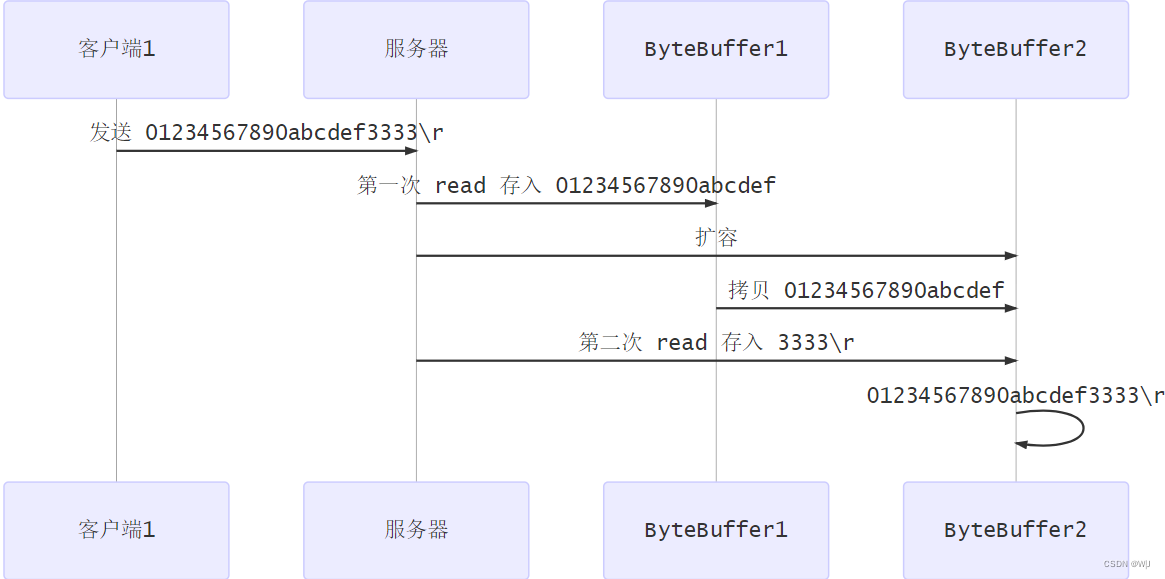
服务端
private static void split(ByteBuffer source) {
source.flip();
for (int i = 0; i < source.limit(); i++) {
// 找到一条完整消息
if (source.get(i) == '\n') {
int length = i + 1 - source.position();
// 把这条完整消息存入新的 ByteBuffer
ByteBuffer target = ByteBuffer.allocate(length);
// 从 source 读,向 target 写
for (int j = 0; j < length; j++) {
target.put(source.get());
}
debugAll(target);
}
}
source.compact(); // 0123456789abcdef position 16 limit 16
}
public static void main(String[] args) throws IOException {
// 1. 创建 selector, 管理多个 channel
Selector selector = Selector.open();
ServerSocketChannel ssc = ServerSocketChannel.open();
ssc.configureBlocking(false);
// 2. 建立 selector 和 channel 的联系(注册)
// SelectionKey 就是将来事件发生后,通过它可以知道事件和哪个channel的事件
SelectionKey sscKey = ssc.register(selector, 0, null);
// key 只关注 accept 事件
sscKey.interestOps(SelectionKey.OP_ACCEPT);
log.debug("sscKey:{}", sscKey);
ssc.bind(new InetSocketAddress(8080));
while (true) {
// 3. select 方法, 没有事件发生,线程阻塞,有事件,线程才会恢复运行
// select 在事件未处理时,它不会阻塞, 事件发生后要么处理,要么取消,不能置之不理
selector.select();
// 4. 处理事件, selectedKeys 内部包含了所有发生的事件
Iterator<SelectionKey> iter = selector.selectedKeys().iterator(); // accept, read
while (iter.hasNext()) {
SelectionKey key = iter.next();
// 处理key 时,要从 selectedKeys 集合中删除,否则下次处理就会有问题
iter.remove();
log.debug("key: {}", key);
// 5. 区分事件类型
if (key.isAcceptable()) { // 如果是 accept
ServerSocketChannel channel = (ServerSocketChannel) key.channel();
SocketChannel sc = channel.accept();
sc.configureBlocking(false);
ByteBuffer buffer = ByteBuffer.allocate(16); // attachment
// 将一个 byteBuffer 作为附件关联到 selectionKey 上
SelectionKey scKey = sc.register(selector, 0, buffer);
scKey.interestOps(SelectionKey.OP_READ);
log.debug("{}", sc);
log.debug("scKey:{}", scKey);
} else if (key.isReadable()) { // 如果是 read
try {
SocketChannel channel = (SocketChannel) key.channel(); // 拿到触发事件的channel
// 获取 selectionKey 上关联的附件
ByteBuffer buffer = (ByteBuffer) key.attachment();
int read = channel.read(buffer); // 如果是正常断开,read 的方法的返回值是 -1
if(read == -1) {
key.cancel();
} else {
split(buffer);
// 需要扩容
if (buffer.position() == buffer.limit()) {
ByteBuffer newBuffer = ByteBuffer.allocate(buffer.capacity() * 2);
buffer.flip();
newBuffer.put(buffer); // 0123456789abcdef3333\n
key.attach(newBuffer);
}
}
} catch (IOException e) {
e.printStackTrace();
key.cancel(); // 因为客户端断开了,因此需要将 key 取消(从 selector 的 keys 集合中真正删除 key)
}
}
}
}
}客户端
SocketChannel sc = SocketChannel.open();
sc.connect(new InetSocketAddress("localhost", 8080));
SocketAddress address = sc.getLocalAddress();
// sc.write(Charset.defaultCharset().encode("hello\nworld\n"));
sc.write(Charset.defaultCharset().encode("0123\n456789abcdef"));
sc.write(Charset.defaultCharset().encode("0123456789abcdef3333\n"));
System.in.read();ByteBuffer 大小分配
-
每个 channel 都需要记录可能被切分的消息,因为 ByteBuffer 不能被多个 channel 共同使用,因此需要为每个 channel 维护一个独立的 ByteBuffer
-
ByteBuffer 不能太大,比如一个 ByteBuffer 1Mb 的话,要支持百万连接就要 1Tb 内存,因此需要设计大小可变的 ByteBuffer
-
一种思路是首先分配一个较小的 buffer,例如 4k,如果发现数据不够,再分配 8k 的 buffer,将 4k buffer 内容拷贝至 8k buffer,优点是消息连续容易处理,缺点是数据拷贝耗费性能,参考实现 Java Resizable Array
-
另一种思路是用多个数组组成 buffer,一个数组不够,把多出来的内容写入新的数组,与前面的区别是消息存储不连续解析复杂,优点是避免了拷贝引起的性能损耗
-
4.5 处理 write 事件
一次无法写完例子
-
非阻塞模式下,无法保证把 buffer 中所有数据都写入 channel,因此需要追踪 write 方法的返回值(代表实际写入字节数)
-
用 selector 监听所有 channel 的可写事件,每个 channel 都需要一个 key 来跟踪 buffer,但这样又会导致占用内存过多,就有两阶段策略
-
当消息处理器第一次写入消息时,才将 channel 注册到 selector 上
-
selector 检查 channel 上的可写事件,如果所有的数据写完了,就取消 channel 的注册
-
如果不取消,会每次可写均会触发 write 事件
-
public class WriteServer {
public static void main(String[] args) throws IOException {
ServerSocketChannel ssc = ServerSocketChannel.open();
ssc.configureBlocking(false);
ssc.bind(new InetSocketAddress(8080));
Selector selector = Selector.open();
ssc.register(selector, SelectionKey.OP_ACCEPT);
while(true) {
selector.select();
Iterator<SelectionKey> iter = selector.selectedKeys().iterator();
while (iter.hasNext()) {
SelectionKey key = iter.next();
iter.remove();
if (key.isAcceptable()) {
SocketChannel sc = ssc.accept();
sc.configureBlocking(false);
SelectionKey sckey = sc.register(selector, SelectionKey.OP_READ);
// 1. 向客户端发送内容
StringBuilder sb = new StringBuilder();
for (int i = 0; i < 3000000; i++) {
sb.append("a");
}
ByteBuffer buffer = Charset.defaultCharset().encode(sb.toString());
int write = sc.write(buffer);
// 3. write 表示实际写了多少字节
System.out.println("实际写入字节:" + write);
// 4. 如果有剩余未读字节,才需要关注写事件
if (buffer.hasRemaining()) {
// read 1 write 4
// 在原有关注事件的基础上,多关注 写事件
sckey.interestOps(sckey.interestOps() + SelectionKey.OP_WRITE);
// 把 buffer 作为附件加入 sckey
sckey.attach(buffer);
}
} else if (key.isWritable()) {
ByteBuffer buffer = (ByteBuffer) key.attachment();
SocketChannel sc = (SocketChannel) key.channel();
int write = sc.write(buffer);
System.out.println("实际写入字节:" + write);
if (!buffer.hasRemaining()) { // 写完了
key.interestOps(key.interestOps() - SelectionKey.OP_WRITE);
key.attach(null);
}
}
}
}
}
}客户端
public class WriteClient {
public static void main(String[] args) throws IOException {
Selector selector = Selector.open();
SocketChannel sc = SocketChannel.open();
sc.configureBlocking(false);
sc.register(selector, SelectionKey.OP_CONNECT | SelectionKey.OP_READ);
sc.connect(new InetSocketAddress("localhost", 8080));
int count = 0;
while (true) {
selector.select();
Iterator<SelectionKey> iter = selector.selectedKeys().iterator();
while (iter.hasNext()) {
SelectionKey key = iter.next();
iter.remove();
if (key.isConnectable()) {
System.out.println(sc.finishConnect());
} else if (key.isReadable()) {
ByteBuffer buffer = ByteBuffer.allocate(1024 * 1024);
count += sc.read(buffer);
buffer.clear();
System.out.println(count);
}
}
}
}
}💡 write 为何要取消
只要向 channel 发送数据时,socket 缓冲可写,这个事件会频繁触发,因此应当只在 socket 缓冲区写不下时再关注可写事件,数据写完之后再取消关注
4.6 更进一步
💡 利用多线程优化
现在都是多核 cpu,设计时要充分考虑别让 cpu 的力量被白白浪费
前面的代码只有一个选择器,没有充分利用多核 cpu,如何改进呢?
分两组选择器
-
单线程配一个选择器,专门处理 accept 事件
-
创建 cpu 核心数的线程,每个线程配一个选择器,轮流处理 read 事件
import cn.itcast.nio.c2c3.ByteBufferUtil;
import lombok.extern.slf4j.Slf4j;
import java.io.IOException;
import java.net.InetSocketAddress;
import java.nio.ByteBuffer;
import java.nio.channels.*;
import java.util.Iterator;
import java.util.concurrent.atomic.AtomicInteger;
@Slf4j
public class MultiThreadServer {
public static void main(String[] args) throws IOException {
ServerSocketChannel ssc = ServerSocketChannel.open();
ssc.bind(new InetSocketAddress(8080));
ssc.configureBlocking(false);
// boss 负责建立连接 work负责读写
Thread.currentThread().setName("boss");
Selector boss = Selector.open();
ssc.register(boss, SelectionKey.OP_ACCEPT);
Work[] works = new Work[Runtime.getRuntime().availableProcessors()];
for (int i = 0; i < works.length; i++) {
String workName = String.format("work-%s", i);
works[i] = new Work(workName);
}
AtomicInteger atomicInteger = new AtomicInteger();
while (true) {
// 会暂停, 直到有新的事件
boss.select();
// 获取 select 的迭代器
Iterator<SelectionKey> iterator = boss.selectedKeys().iterator();
if (iterator.hasNext()) {
SelectionKey key = iterator.next();
if (key.isAcceptable()) {
// SocketChannel socketChannel = ((ServerSocketChannel) key.channel()).accept();
SocketChannel socketChannel = ssc.accept();
socketChannel.configureBlocking(false);
works[atomicInteger.getAndIncrement() % works.length].register(socketChannel);
log.debug("connected {}", socketChannel);
}
iterator.remove();
}
}
}
/**
* 关注读写事件
*/
static class Work implements Runnable {
private String name;
private Thread thread;
private Selector selector;
private volatile boolean isRegister = false;
private Runnable runnable;
public Work(String name) {
this.name = name;
}
public void register(SocketChannel socketChannel) {
if (!this.isRegister) {
this.isRegister = true;
try {
this.selector = Selector.open();
} catch (IOException e) {
e.printStackTrace();
}
this.thread = new Thread(this, this.name);
this.thread.start();
}
runnable = () -> {
try {
socketChannel.register(this.selector, SelectionKey.OP_READ);
} catch (ClosedChannelException e) {
e.printStackTrace();
}
};
selector.wakeup();
}
@Override
public void run() {
while (true) {
log.debug("Waiting for,{}", selector);
try {
this.selector.select();
if (runnable != null) {
runnable.run();
}
Iterator<SelectionKey> iterator = this.selector.selectedKeys().iterator();
while (iterator.hasNext()) {
SelectionKey key = iterator.next();
if (key.isReadable()) {
SocketChannel sc = (SocketChannel) key.channel();
log.debug("getChannel,{},", sc);
// 忽略断开连接 key.cancel(); 粘包半包的情况
ByteBuffer byteBuffer = ByteBuffer.allocate(16);
sc.read(byteBuffer);
log.debug("read.{}", sc.getRemoteAddress());
byteBuffer.flip();
ByteBufferUtil.debugAll(byteBuffer);
}
iterator.remove();
}
} catch (IOException e) {
e.printStackTrace();
}
}
}
}
}
5. NIO vs BIO
5.1 stream vs channel
-
stream 不会自动缓冲数据,channel 会利用系统提供的发送缓冲区、接收缓冲区(更为底层)
-
stream 仅支持阻塞 API,channel 同时支持阻塞、非阻塞 API,网络 channel 可配合 selector 实现多路复用
-
二者均为全双工,即读写可以同时进行
5.2 IO 模型
同步阻塞、同步非阻塞、同步多路复用、异步非阻塞
-
同步:线程自己去获取结果(一个线程)
-
异步:线程自己不去获取结果,而是由其它线程送结果(至少两个线程)
当调用一次 channel.read 或 stream.read 后,会切换至操作系统内核态来完成真正数据读取,而读取又分为两个阶段,分别为:
-
等待数据阶段
-
复制数据阶段
阻塞 IO
非阻塞 IO

多路复用

异步 IO

阻塞 IO vs 多路复用
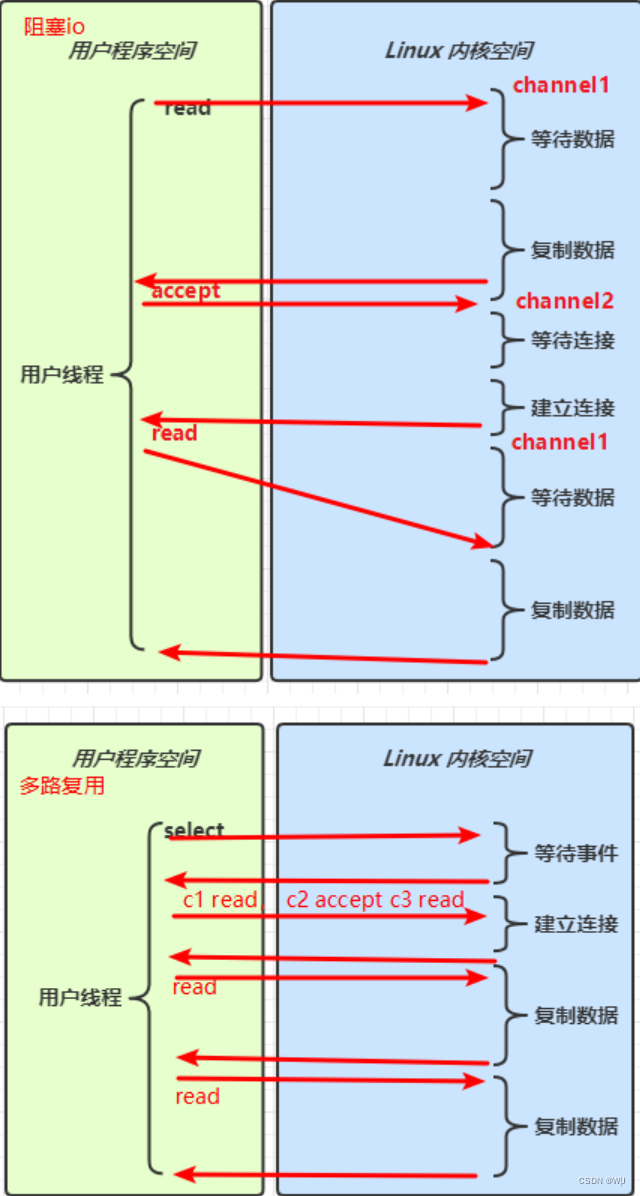
5.3 AIO
AIO 用来解决数据复制阶段的阻塞问题
-
同步意味着,在进行读写操作时,线程需要等待结果,还是相当于闲置
-
异步意味着,在进行读写操作时,线程不必等待结果,而是将来由操作系统来通过回调方式由另外的线程来获得结果
异步模型需要底层操作系统(Kernel)提供支持
Windows 系统通过 IOCP 实现了真正的异步 IO
Linux 系统异步 IO 在 2.6 版本引入,但其底层实现还是用多路复用模拟了异步 IO,性能没有优势
文件 AIO
先来看看 AsynchronousFileChannel
@Slf4j
public class AioDemo1 {
public static void main(String[] args) throws IOException {
try{
AsynchronousFileChannel s =
AsynchronousFileChannel.open(
Paths.get("1.txt"), StandardOpenOption.READ);
ByteBuffer buffer = ByteBuffer.allocate(2);
log.debug("begin...");
s.read(buffer, 0, null, new CompletionHandler<Integer, ByteBuffer>() {
@Override
public void completed(Integer result, ByteBuffer attachment) {
log.debug("read completed...{}", result);
buffer.flip();
debug(buffer);
}
@Override
public void failed(Throwable exc, ByteBuffer attachment) {
log.debug("read failed...");
}
});
} catch (IOException e) {
e.printStackTrace();
}
log.debug("do other things...");
System.in.read();
}
}网络 AIO
public class AioServer {
public static void main(String[] args) throws IOException {
AsynchronousServerSocketChannel ssc = AsynchronousServerSocketChannel.open();
ssc.bind(new InetSocketAddress(8080));
ssc.accept(null, new AcceptHandler(ssc));
System.in.read();
}
private static void closeChannel(AsynchronousSocketChannel sc) {
try {
System.out.printf("[%s] %s close\n", Thread.currentThread().getName(), sc.getRemoteAddress());
sc.close();
} catch (IOException e) {
e.printStackTrace();
}
}
private static class ReadHandler implements CompletionHandler<Integer, ByteBuffer> {
private final AsynchronousSocketChannel sc;
public ReadHandler(AsynchronousSocketChannel sc) {
this.sc = sc;
}
@Override
public void completed(Integer result, ByteBuffer attachment) {
try {
if (result == -1) {
closeChannel(sc);
return;
}
System.out.printf("[%s] %s read\n", Thread.currentThread().getName(), sc.getRemoteAddress());
attachment.flip();
System.out.println(Charset.defaultCharset().decode(attachment));
attachment.clear();
// 处理完第一个 read 时,需要再次调用 read 方法来处理下一个 read 事件
sc.read(attachment, attachment, this);
} catch (IOException e) {
e.printStackTrace();
}
}
@Override
public void failed(Throwable exc, ByteBuffer attachment) {
closeChannel(sc);
exc.printStackTrace();
}
}
private static class WriteHandler implements CompletionHandler<Integer, ByteBuffer> {
private final AsynchronousSocketChannel sc;
private WriteHandler(AsynchronousSocketChannel sc) {
this.sc = sc;
}
@Override
public void completed(Integer result, ByteBuffer attachment) {
// 如果作为附件的 buffer 还有内容,需要再次 write 写出剩余内容
if (attachment.hasRemaining()) {
sc.write(attachment);
}
}
@Override
public void failed(Throwable exc, ByteBuffer attachment) {
exc.printStackTrace();
closeChannel(sc);
}
}
private static class AcceptHandler implements CompletionHandler<AsynchronousSocketChannel, Object> {
private final AsynchronousServerSocketChannel ssc;
public AcceptHandler(AsynchronousServerSocketChannel ssc) {
this.ssc = ssc;
}
@Override
public void completed(AsynchronousSocketChannel sc, Object attachment) {
try {
System.out.printf("[%s] %s connected\n", Thread.currentThread().getName(), sc.getRemoteAddress());
} catch (IOException e) {
e.printStackTrace();
}
ByteBuffer buffer = ByteBuffer.allocate(16);
// 读事件由 ReadHandler 处理
sc.read(buffer, buffer, new ReadHandler(sc));
// 写事件由 WriteHandler 处理
sc.write(Charset.defaultCharset().encode("server hello!"), ByteBuffer.allocate(16), new WriteHandler(sc));
// 处理完第一个 accpet 时,需要再次调用 accept 方法来处理下一个 accept 事件
ssc.accept(null, this);
}
@Override
public void failed(Throwable exc, Object attachment) {
exc.printStackTrace();
}
}
}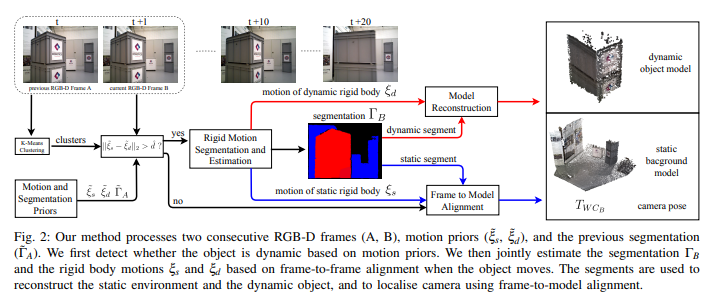






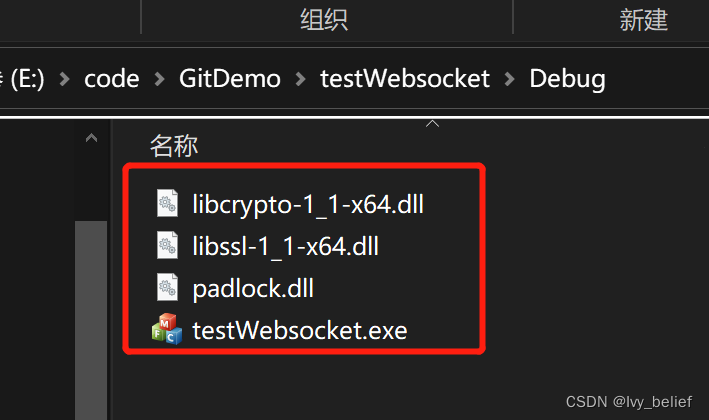


![深度学习应用篇-推荐系统[11]:推荐系统的组成、场景转化指标(pv点击率,uv点击率,曝光点击率)、用户数据指标等评价指标详解](https://img-blog.csdnimg.cn/img_convert/3be20f20fef024e998854b404aa0f662.png)



